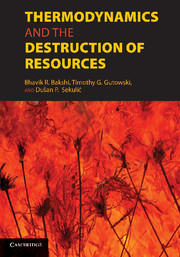Book contents
- Frontmatter
- Contents
- Contributor List
- Foreword by Herman E. Daly
- Foreword by Jan Szargut
- Preface
- Introduction
- PART I FOUNDATIONS
- PART II PRODUCTS AND PROCESSES
- 4 Materials Separation and Recycling
- 5 An Entropy-Based Metric for a Transformational Technology Development
- 6 Thermodynamic Analysis of Resources Used in Manufacturing Processes
- 7 Ultrapurity and Energy Use: Case Study of Semiconductor Manufacturing
- 8 Energy Resources and Use: The Present Situation, Possible Sustainable Paths to the Future, and the Thermodynamic Perspective
- PART III LIFE-CYCLE ASSESSMENTS AND METRICS
- PART IV ECONOMIC SYSTEMS, SOCIAL SYSTEMS, INDUSTRIAL SYSTEMS, AND ECOSYSTEMS
- Appendix: Standard Chemical Exergy
- Index
- References
7 - Ultrapurity and Energy Use: Case Study of Semiconductor Manufacturing
Published online by Cambridge University Press: 01 June 2011
- Frontmatter
- Contents
- Contributor List
- Foreword by Herman E. Daly
- Foreword by Jan Szargut
- Preface
- Introduction
- PART I FOUNDATIONS
- PART II PRODUCTS AND PROCESSES
- 4 Materials Separation and Recycling
- 5 An Entropy-Based Metric for a Transformational Technology Development
- 6 Thermodynamic Analysis of Resources Used in Manufacturing Processes
- 7 Ultrapurity and Energy Use: Case Study of Semiconductor Manufacturing
- 8 Energy Resources and Use: The Present Situation, Possible Sustainable Paths to the Future, and the Thermodynamic Perspective
- PART III LIFE-CYCLE ASSESSMENTS AND METRICS
- PART IV ECONOMIC SYSTEMS, SOCIAL SYSTEMS, INDUSTRIAL SYSTEMS, AND ECOSYSTEMS
- Appendix: Standard Chemical Exergy
- Index
- References
Summary
Introduction
The notion that technological progress leads to reduced demand of materials and energy to manufacture products and deliver services is known as dematerialization [1]. The conventional conception of dematerialization views products and services as static, and from this perspective technological progress can but mitigate the impact per product produced. A demand for increased functionality and performance, however, induces changes in products. Automobiles, computers, and cell phones, for example, have become significantly more complex over the past two decades. A more complex design generally implies tighter tolerances in materials, parts, and manufacturing processes. Semiconductor, nanotechnology, and pharmaceutical manufacturing in particular require chemicals and processing environments that are much purer than traditional industries. Viewing this trend through the lens of thermodynamics, one can assert that the entropy of many products has been decreasing as a function of increasing sophistication. The second law of thermodynamics dictates that the entropy of an isolated system cannot decrease. A purified separation has lower entropy than a mixed one; thus purification implies interaction with the external world. In practice, this interaction is subjecting the system to processes that involve net inflows of energy, e.g., distillation. Purification in practice requires the input of energy, suggesting that increasing complexity should come at a cost of additional processing. This additional processing requires additional secondary energy and materials to attain the desired low-entropy form, a trend we call secondary materialization [2].
- Type
- Chapter
- Information
- Thermodynamics and the Destruction of Resources , pp. 190 - 211Publisher: Cambridge University PressPrint publication year: 2011
References
- 3
- Cited by



